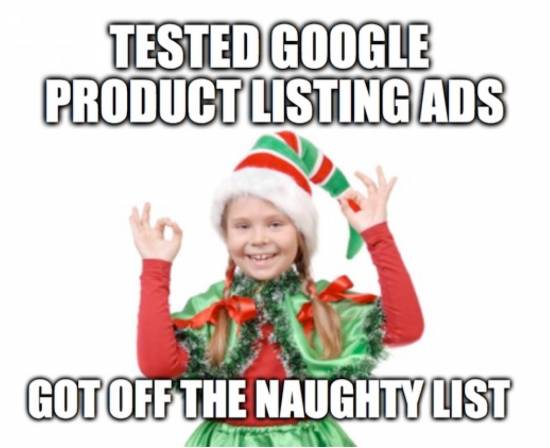 It’s that wonderful time of year again when merchants scramble to implement and solidify their Q4 holiday shopping season strategy. The most profitable time of the year for all retail, Q4, consistently poses new challenges to merchants as ecommerce technology grows and the online retail space becomes more crowded. And now more than ever, Google has its large hands in ecommerce.
It’s that wonderful time of year again when merchants scramble to implement and solidify their Q4 holiday shopping season strategy. The most profitable time of the year for all retail, Q4, consistently poses new challenges to merchants as ecommerce technology grows and the online retail space becomes more crowded. And now more than ever, Google has its large hands in ecommerce.
Enter Google Product Listing Ads.
Comparison Shopping Engine Product Advertising
One of the most effective ways to market products during Q4 is to advertise on comparison shopping engines. With consumers flocking online to make their holiday purchases, the increased traffic is driven to sites like Nextag, PriceGrabber, Shopzilla, and Shopping.com. These are paid price comparison websites, meaning retailers pay the popular shopping sites a cost per click (CPC) bid for every click through to their own store.
The increase in traffic during Q4 greatly benefits both retailers and comparison shopping engines alike, but in the course of just 1 year, Google Product Listing Ads has cast a very large shadow over this process. Since transitioning to a paid model in May 2012, Google Product Listing Ads have become the absolute superstar for product advertising. RELATED CLASS: Google Shopping: Strategies and Best Practices for Success
Google Product Listing Ads Performance Data
Also known as Google Shopping or Google PLAs, Google Product Listing Ads’ performance is well-documented in CPC Strategy’s The Comparison Shopping Report. During last year’s holiday shopping season (Q4 2012), Google Product Listing Ads:
- Drove 61% more traffic than 2nd place PriceGrabber
- Had the lowest cost of sale (COS) with 11%
- Had the lowest average CPC rate with around $0.31
- And was also 1st in overall revenue generated
Not surprisingly, Google Product Listing Ads was ranked the #1 comparison shopping engine in overall Q4 performance.
But the data gets more astounding.
Everyone knows Q4 is THE peak performing quarter for sales numbers. That’s why it was so surprising to see that from Q4 2012 to Q1 2013, Google Product Listing Ads generated 82% more traffic and 30% more revenue than it did during the holiday shopping season. Additionally, Google Product Listing Ad conversion rates increased from 2.4% to 3.30%.
And the growth only continues into Q2 2013. Google’s paid CSE grew 40% in traffic and 66% in revenue generated from Q1 2013. Conversion rates also increased from 3.30% t0 3.41%. Below is Google Product Listing Ads’ Q2 2013 traffic stacked up against the rest of major comparison shopping engines.
Google PLA’s steady, fast rate of growth combined with the traffic-heavy (and growing) holiday shopping season makes it a ridiculously capable marketing channel. So, yeah, Google Product Listing Ads is poised for some big things this Q4 2013.
Google Product Listing Ads Best Practices
For this Q4 2013, it’s important to revamp your Google Product List Ads strategy a bit to compensate for the increased traffic and competition. You should be familiar with general Google PLA best practices, but here are a few quick ones for Q4 2013:
- Bidding: An aggressive bid strategy is key here. It’s most important that you aggressively bid higher on your top-performing products. Consequentially, you need to raise your ad spend budget for q4 to compensate for your increased bids. You need to put more money out on the table if you hope to cash in big. Also be sure to bid up on seasonal products (items usually given as presents, winter apparel, Halloween products, Christmas-related products, etc.)
- Free Shipping: If you don’t already, figure out a way to offer free shipping even if it’s just for the holiday season. Google Product Listing Ads makes it very easy to filter by shipping, which is an extremely common practice for online shoppers. As always, make sure your fulfillment department is ready to handle the natural increase in orders.
- Feed: The last thing you want is for your PLA campaign to stall because of a faulty feed. There are a couple reasons why this can happen: you have included restricted products in your feed, or your feed isn’t formatted correctly. Google Merchant Account suspensions can be fatal, so familiarize yourself on how you can overcome these. Also, be sure to include as much relevant content in your feeds as possible to account for long-tail, specific queries (which are common during holiday season shopping).
Oh, and if you didn’t get the point yet, you should really consider getting started with Google Product Listing Ads.
Learn how to drive more ecommerce transactions with Google Product Listing Ads.
Watch Google Shopping Overview: Strategies and Tactics for Success, and start leveraging Google Product Listing Ads (part of Google Shopping) to drive more transactions today. You'll see how to integrate Google Product Listing Ads into your current search strategy, and get expert tips for optimizing your PPC spend. Activate trial now.